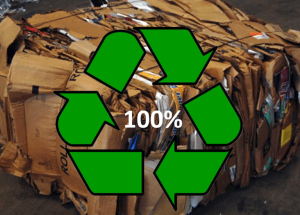Recycled content is central to the “Circular Economy” approach that Ontario and some other provinces say they want to adopt. It keeps raw materials flowing through the economy longer, reduces the pressure to extract more virgin materials from the earth, and delays their eventual disposal as waste. It’s something which governments say they want to encourage, and for which stewards of paper products and packaging should be rewarded.
The Canadian paper packaging industry has spent millions of dollars over the years investing in cleaning and screening machinery so that it can re-use and recycle recovered paper. Packaging mills in Southern Ontario led North America in recycling old boxboard for the first time back in the 1990s. Today, some 94% of Canadians can recycle it. And today, most of the corrugated boxes and boxboard cartons made in Ontario are continuously made from 100% recycled content, a circular achievement in and of itself.
The paper packaging industry gets no credit for this effort, while in the commercial marketplace it competes against mostly virgin packaging alternatives. We have suggested the province level the playing field by setting a target of 40% average recycled content for all packaging sold in Ontario by 2020 and an average of 70% within 10 years. This would place Ontario firmly on the path to the circular economy it says it wants, and create a more level playing field between materials at the same time.

An alternative to provincial regulation is a recycled content credit within the Blue Box funding formula itself. This is not a new suggestion. The producer responsibility organisation in Quebec, Éco Entreprises Québec, already has one. And while Stewardship Ontario does float the idea of a recycled content credit in the draft outline of the new Blue Box plan it is currently working on, its support seems rather tepid.
That’s because some Ontario stewards have objected to the concept in the past. Here are three historical objections, and our responses to them.
- That assessing recycled content is an administrative burden and costly to track and report.
We think this objection is way overstated. For paper materials we have independent third-party certifiers and chain-of-custody certifications as to where paper materials are coming from, whether from virgin or recycled sources, or a mix of the two. Chain-of-custody certification is an environmental metric supported by the global Consumer Goods Forum, of which most leading Canadian brands and retailers are members.
Making suppliers prove that they have internationally accepted chain-of-custody certification would seem to reduce the administrative burden on stewards and provide a good kick-start to the circular economy at the same time. It would also force other materials to develop chain-of-custody certification programs if they haven’t already done so.
Or stewards could use independently certified industry averages. PPEC has been tracking its members’ use of recycled content for over 25 years and it’s quite willing to open its books to a confidential third-party review. A sliding scale of recycled content usage would reward a lot more stewards and probably be more palatable and make any administration easier. Besides, won’t the new body Ontario has created to bring in the Circular Economy (the Resource Productivity and Recovery Authority) be monitoring this anyway?
- The funds to credit stewards using recycled content must come from other stewards (i.e. it is cross-substitution).
Well yes, it is. That’s why you do it, to encourage other stewards to be more circular, to reduce the overall environmental burden of the basket of goods that is the Blue Box, for the common benefit. This is the very same principle that’s supposed to apply to those materials that are recycled through the Blue Box versus the ones that are not. What’s the difference? It’s the same principle of rewarding preferred behaviour.
- Federal regulations limit the use of recycled content in food-contact packaging. Making recycled content a requirement would be unfair to those stewards.
First, federal regulations on food-contact packaging apply to all materials (i.e. it is material-neutral). Second, recycled content is not excluded. Food safety is the key issue and the onus is on the brand owner to guarantee food safety, whether through Health Canada “No Objection Letters” or through FDA approvals. It comes down to the material’s direct and indirect contact with the food and the element of risk to humans.
Is it unfair to single out “food” stewards? No. They choose to be producers of foods and the safe delivery of food is part of that. Just as a producer of a washing machine or a microwave is “forced” to use a large package to have his or her product delivered. Or a perfume manufacturer with an elaborately designed stand-out boxboard carton. All choose of their own free will to be in those lines of business. That’s the game they’ve chosen to be in. Whether they can use recycled content or not in their delivery packaging is part and parcel of that original choice.
In summary, rewarding those who use recycled content is a good, fair, and effective way to achieve a circular economy and to level the playing field between “circular” and “non-circular” performers. Isn’t that what we’re supposed to be doing?

john
you always have thoughts provoting ideas. i like it
emmie